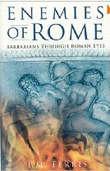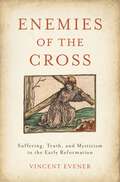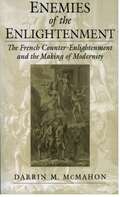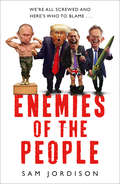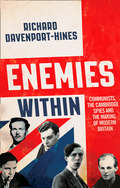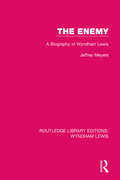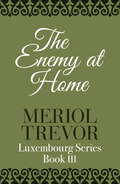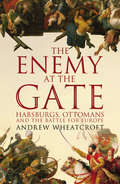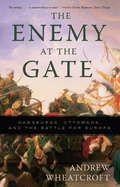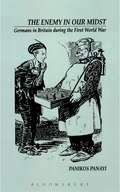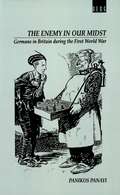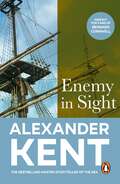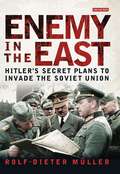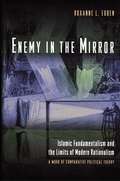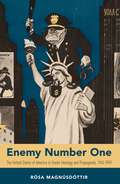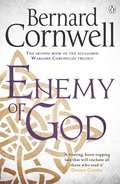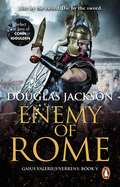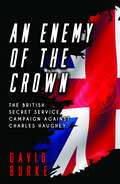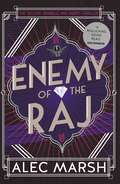- Table View
- List View
Enemies of Rome: Barbarians Through Roman Eyes
by Iain FerrisThe artists of Ancient Rome portrayed the barbarian enemies of the empire in sculpture, reliefs, metalwork and jewellery. Enemies of Rome shows how the study of these images can reveal a great deal about the barbarians, as well as Roman art and the Romans view of themselves.
Enemies of the Cross: Suffering, Truth, and Mysticism in the Early Reformation
by Vincent EvenerEnemies of the Cross examines how suffering and truth were aligned in the divisive debates of the early Reformation. Vincent Evener explores how Martin Luther, along with his first intra-Reformation critics, offered "true" suffering as a crucible that would allow believers to distinguish the truth or falsehood of doctrine, teachers, and their own experiences. To use suffering in this way, however, reformers also needed to teach Christians to recognize false suffering and the false teachers who hid under its mantle. This book contends that these arguments, which became an enduring part of the Lutheran and radical traditions, were nourished by the reception of a daring late-medieval mystical tradition the post-Eckhartian which depicted annihilation of the self as the way to union with God. The first intra-Reformation dissenters, Andreas Bodenstein von Karlstadt and Thomas Müntzer, have frequently been depicted as champions of medieval mystical views over and against the non-mystical Luther. Evener counters this depiction by showing how Luther, Karlstadt, and Müntzer developed their shared mystical tradition in diverse directions, while remaining united in the conviction that sinful self-assertion prevented human beings from receiving truth and living in union with God. He argues that Luther, Karlstadt, and Müntzer each represented a different form of ecclesial-political dissent shaped by a mystical understanding of how Christians were united to God through the destruction of self-assertion. Enemies of the Cross draws on seldom-used sources and proposes new concepts of "revaluation" and "relocation" to describe how Protestants and radicals brought medieval mystical teachings into new frameworks that rejected spiritual hierarchy.
Enemies of the Cross: Suffering, Truth, and Mysticism in the Early Reformation
by Vincent EvenerEnemies of the Cross examines how suffering and truth were aligned in the divisive debates of the early Reformation. Vincent Evener explores how Martin Luther, along with his first intra-Reformation critics, offered "true" suffering as a crucible that would allow believers to distinguish the truth or falsehood of doctrine, teachers, and their own experiences. To use suffering in this way, however, reformers also needed to teach Christians to recognize false suffering and the false teachers who hid under its mantle. This book contends that these arguments, which became an enduring part of the Lutheran and radical traditions, were nourished by the reception of a daring late-medieval mystical tradition the post-Eckhartian which depicted annihilation of the self as the way to union with God. The first intra-Reformation dissenters, Andreas Bodenstein von Karlstadt and Thomas Müntzer, have frequently been depicted as champions of medieval mystical views over and against the non-mystical Luther. Evener counters this depiction by showing how Luther, Karlstadt, and Müntzer developed their shared mystical tradition in diverse directions, while remaining united in the conviction that sinful self-assertion prevented human beings from receiving truth and living in union with God. He argues that Luther, Karlstadt, and Müntzer each represented a different form of ecclesial-political dissent shaped by a mystical understanding of how Christians were united to God through the destruction of self-assertion. Enemies of the Cross draws on seldom-used sources and proposes new concepts of "revaluation" and "relocation" to describe how Protestants and radicals brought medieval mystical teachings into new frameworks that rejected spiritual hierarchy.
Enemies of the Enlightenment: The French Counter-Enlightenment and the Making of Modernity
by Darrin M. McMahonCritics have long treated the most important intellectual movement of modern history--the Enlightenment--as if it took shape in the absence of opposition. In this groundbreaking new study, Darrin McMahon demonstrates that, on the contrary, contemporary resistance to the Enlightenment was a major cultural force, shaping and defining the Enlightenment itself from the moment of inception, while giving rise to an entirely new ideological phenomenon-what we have come to think of as the "Right." McMahon skillfully examines the Counter-Enlightenment, showing that it was an extensive, international, and thoroughly modern affair.
Enemies of the Enlightenment: The French Counter-Enlightenment and the Making of Modernity
by Darrin M. McMahonCritics have long treated the most important intellectual movement of modern history--the Enlightenment--as if it took shape in the absence of opposition. In this groundbreaking new study, Darrin McMahon demonstrates that, on the contrary, contemporary resistance to the Enlightenment was a major cultural force, shaping and defining the Enlightenment itself from the moment of inception, while giving rise to an entirely new ideological phenomenon-what we have come to think of as the "Right." McMahon skillfully examines the Counter-Enlightenment, showing that it was an extensive, international, and thoroughly modern affair.
Enemies of the People
by Sam JordisonSomething has gone wrong. We're living in an age of celebratory racism, extreme inequality, uncertainty and fear. We're governed by people who claim to be populist but who seem to hate everyone. There are idiots at the wheel and we're heading for a cliff in a big red bus and no one knows how to save us.
Enemies Within: Communists, The Cambridge Spies And The Making Of Modern Britain
by Richard Davenport-HinesWhat pushed Blunt, Burgess, Cairncross, Maclean and Philby into Soviet hands? With access to recently released papers and other neglected documents, this sharp analysis of the intelligence world examines how and why these men and others betrayed their country and what this cost Britain and its allies.
The Enemy: A Biography of Wyndham Lewis (Routledge Library Editions: Wyndham Lewis #1)
by Jeffrey MeyersOriginally published in 1980 and nominated for the Duff Cooper Prize, this was the first biography of Wyndham Lewis and was based on extensive archival research and interviews. It narrates Lewis’ years at Rugby and the Slade, his bohemian life on the Continent, the creation of Vorticism and publication of Blast, and his experiences at Passchendaele, as well as his many love affairs, his bitter quarrels with Bloomsbury and the Sitwells, the suppressed books of the thirties, the evolution of his political ideas, his self-imposed exile in North America and creative resurgence during his final blindness. Jeffrey Meyers also describes Lewis’ relationships with Roy Campbell, D. H. Lawrence, Katherine Mansfield, T. E Lawrence, Hemingway, Huxley, Yeats, Auden, Spender, Orwell and McLuhan. As the self-styled Enemy emerges from the shadows, he is seen as an independent and courageous artist and one of the most controversial and stimulating figures in modern English art and literature.
The Enemy: A Biography of Wyndham Lewis (Routledge Library Editions: Wyndham Lewis #1)
by Jeffrey MeyersOriginally published in 1980 and nominated for the Duff Cooper Prize, this was the first biography of Wyndham Lewis and was based on extensive archival research and interviews. It narrates Lewis’ years at Rugby and the Slade, his bohemian life on the Continent, the creation of Vorticism and publication of Blast, and his experiences at Passchendaele, as well as his many love affairs, his bitter quarrels with Bloomsbury and the Sitwells, the suppressed books of the thirties, the evolution of his political ideas, his self-imposed exile in North America and creative resurgence during his final blindness. Jeffrey Meyers also describes Lewis’ relationships with Roy Campbell, D. H. Lawrence, Katherine Mansfield, T. E Lawrence, Hemingway, Huxley, Yeats, Auden, Spender, Orwell and McLuhan. As the self-styled Enemy emerges from the shadows, he is seen as an independent and courageous artist and one of the most controversial and stimulating figures in modern English art and literature.
The Enemy At Home (Luxembourg #3)
by Meriol TrevorFor Seraphine de Trévires, love would have to wait. It was marriage she longed for - marriage to Dominique d'Erlen, traitor and usurper of his brother's estates. But this was the time of the French revolution; armies were on the march and disaster threatened all of Europe. The loveless union was Seraphine's only hope of seeing Paris and the glittering world of her dreams. And then she met the handsome English soldier who, left by the French to die in a forgotten dungeon, so completely won her heart that love left her no choice. No choice, but instead an agonizing decision...
The Enemy at the Gate: Habsburgs, Ottomans and the Battle for Europe
by Andrew WheatcroftIn 1683, two empires - the Ottoman, based in Constantinople, and the Habsburg dynasty in Vienna - came face to face in the culmination of a 250-year power struggle: the Great Siege of Vienna. Within the city walls the choice of resistance over surrender to the largest army ever assembled by the Turks created an all-or-nothing scenario: every last survivor would be enslaved or ruthlessly slaughtered. The Turks had set their sights on taking Vienna, the city they had long called 'The Golden Apple' since their first siege of the city in 1529. Both sides remained resolute, sustained by hatred of their age-old enemy, certain that their victory would be won by the grace of God.Eastern invaders had always threatened the West: Huns, Mongols, Goths, Visigoths, Vandals and many others. The Western fears of the East were vivid and powerful and, in their new eyes, the Turks always appeared the sole aggressors. Andrew Wheatcroft's extraordinary book shows that this belief is a grievous oversimplification: during the 400 year struggle for domination, the West took the offensive just as often as the East. As modern Turkey seeks to re-orient its relationship with Europe, a new generation of politicians is exploiting the residual fears and tensions between East and West to hamper this change. The Enemy at the Gate provides a timely and masterful account of this most complex and epic of conflicts.
The Enemy at the Gate: Habsburgs, Ottomans, and the Battle for Europe
by Andrew WheatcroftAn acclaimed history of the Great Siege of Vienna, when the Ottoman Empire and the Habsburg dynasty came face to faceIn 1683, an Ottoman army that stretched from horizon to horizon set out to seize Vienna, the bulwark of Christendom. The ensuing siege pitted battle-hardened Janissaries wielding seventeenth-century grenades against Habsburg armies widely feared for their savagery. The walls of Vienna bristled with guns as the besieging Ottoman host launched bombs, fired cannons, and showered the populace with arrows. Each side was sustained by the hatred of its age-old enemy, certain that victory would be won by the grace of God.The Great Siege of Vienna is the centerpiece of historian Andrew Wheatcroft's richly drawn portrait of the complex centuries-long rivalry between the Ottoman and Habsburg empires for control of the European continent. A gripping work by a master historian, The Enemy at the Gate offers a timely examination of an epic clash of civilizations.
Enemy in our Midst: Germans in Britain during the First World War
by Panikos PanayiWith the approach of the First World War, the German community in Britain began to be assailed by a combination of government measures and popular hostility which resulted in attacks against individuals with German connections and confiscation of their property. From May 1915, a policy of wholesale internment and repatriation was to reduce the German population by more than half of its pre-war figure. The author of this study charts the growth of the German community in Britain before detailing the story of its destruction under the chauvinistic intolerance which gripped the country during the Great War.
Enemy in our Midst: Germans in Britain during the First World War
by Panikos PanayiWith the approach of the First World War, the German community in Britain began to be assailed by a combination of government measures and popular hostility which resulted in attacks against individuals with German connections and confiscation of their property. From May 1915, a policy of wholesale internment and repatriation was to reduce the German population by more than half of its pre-war figure. The author of this study charts the growth of the German community in Britain before detailing the story of its destruction under the chauvinistic intolerance which gripped the country during the Great War.
Enemy In Sight: (The Richard Bolitho adventures: 12): an all-action, all-guns-blazing adventure on the high seas from the master storyteller of the sea (Richard Bolitho #12)
by Alexander KentFans of Patrick O'Brian and C. S. Forester will love this engrossing and enthralling naval adventure from multi-million copy seller Alexander Kent. You'll be gripped from page one!'One of our foremost writers of naval fiction' -- Sunday Times'As a former naval officer, Alexander Kent knows what it is like to be at sea' -- The Times'Impossible to put down!' -- ***** Reader review'Plenty of action and intrigue to keep you wanting to read just one more chapter' -- ***** Reader review'As ever, the author keeps you totally involved. A true page turner.' -- ***** Reader review'A jolly good read and difficult to put down' -- ***** Reader review'Outstanding' -- ***** Reader review**************************************************************************************1794: as the year draws to a close Richard Bolitho, commanding the old Hyperion, leaves Plymouth to join a squadron blockading the rising power of Revolutionary France. After six months of repairs his ship is ready to fight again, but her company is mostly raw and untrained.Unfortunately, Bolitho finds himself under a commodore who is no match for the French admiral, Lequiller, whose powerful squadron uses guile and ruthless determination to elude him and vanish into the Atlantic. Hyperion gives chase, the desperate voyage taking them from the Bay of Biscay's squall to the heat of the Caribbean - and for each mile sailed and every battle fought, Bolitho finds himself being forced into the ever more demanding role of strategist and squadron commander.Is he up to the challenge?Bolitho's adventures continue in The Flag Captain.
Enemy in the East: Hitler's Secret Plans to Invade the Soviet Union
by Rolf-Dieter MüllerOperation Barbarossa, Hitler's invasion of the Soviet Union in 1941, led to one of the most brutal campaigns of World War II: of the estimated 70 million people who died in World War II, over 30 million died on the Eastern Front. Although it has previously been argued that the campaign was a pre-emptive strike, in fact, Hitler had been planning a war of intervention against the USSR ever since he came to power in 1933. Using previously unseen sources, acclaimed military historian Rolf-Dieter Müller shows that Hitler and the Wehrmacht had begun to negotiate with Poland and had even considered an alliance with Japan soon after taking power. Despite the signing of the Molotov-Ribbentrop Pact, at the declaration of war in September 1939, military engagement with the Red Army was still a very real and imminent possibility. In this book, Müller takes us behind the scenes of the Wehrmacht High Command, providing a fascinating insight into an unknown story of World War II.
Enemy in the Mirror: A Work of Comparative Political Theory
by Roxanne L. EubenA firm grasp of Islamic fundamentalism has often eluded Western political observers, many of whom view it in relation to social and economic upheaval or explain it away as an irrational reaction to modernity. Here Roxanne Euben makes new sense of this belief system by revealing it as a critique of and rebuttal to rationalist discourse and post-Enlightenment political theories. Euben draws on political, postmodernist, and critical theory, as well as Middle Eastern studies, Islamic thought, comparative politics, and anthropology, to situate Islamic fundamentalist thought within a transcultural theoretical context. In so doing, she illuminates an unexplored dimension of the Islamist movement and holds a mirror up to anxieties within contemporary Western political thought about the nature and limits of modern rationalism--anxieties common to Christian fundamentalists, postmodernists, conservatives, and communitarians. A comparison between Islamic fundamentalism and various Western critiques of rationalism yields formerly uncharted connections between Western and Islamic political thought, allowing the author to reclaim an understanding of political theory as inherently comparative. Her arguments bear on broad questions about the methods Westerners employ to understand movements and ideas that presuppose nonrational, transcendent truths. Euben finds that first, political theory can play a crucial role in understanding concrete political phenomena often considered beyond its jurisdiction; second, the study of such phenomena tests the scope of Western rationalist categories; and finally, that Western political theory can be enriched by exploring non-Western perspectives on fundamental debates about coexistence.
Enemy in the Mirror: Islamic Fundamentalism and the Limits of Modern Rationalism: A Work of Comparative Political Theory
by Roxanne L. EubenA firm grasp of Islamic fundamentalism has often eluded Western political observers, many of whom view it in relation to social and economic upheaval or explain it away as an irrational reaction to modernity. Here Roxanne Euben makes new sense of this belief system by revealing it as a critique of and rebuttal to rationalist discourse and post-Enlightenment political theories. Euben draws on political, postmodernist, and critical theory, as well as Middle Eastern studies, Islamic thought, comparative politics, and anthropology, to situate Islamic fundamentalist thought within a transcultural theoretical context. In so doing, she illuminates an unexplored dimension of the Islamist movement and holds a mirror up to anxieties within contemporary Western political thought about the nature and limits of modern rationalism--anxieties common to Christian fundamentalists, postmodernists, conservatives, and communitarians. A comparison between Islamic fundamentalism and various Western critiques of rationalism yields formerly uncharted connections between Western and Islamic political thought, allowing the author to reclaim an understanding of political theory as inherently comparative. Her arguments bear on broad questions about the methods Westerners employ to understand movements and ideas that presuppose nonrational, transcendent truths. Euben finds that first, political theory can play a crucial role in understanding concrete political phenomena often considered beyond its jurisdiction; second, the study of such phenomena tests the scope of Western rationalist categories; and finally, that Western political theory can be enriched by exploring non-Western perspectives on fundamental debates about coexistence.
Enemy Number One: The United States of America in Soviet Ideology and Propaganda, 1945-1959
by Rósa MagnúsdóttirEnemy Number One tells the story of the Soviet cultural and propaganda apparatus and its efforts to control information about the United States in the postwar landscape. Beginning with the 1945 meeting of American and Soviet troops on the Elbe, this period saw cultural relations develop in close connection to oppression as the Soviet authorities attempted to contain and appropriate images of the United States. Rósa Magnúsdóttir analyzes two official narratives about the USSR's "enemy number one" --Stalin's anti-American campaign and Khrushchev's policy of peaceful coexistence--and shows how each relied on the legacy of the wartime alliance in their approach. Stalin used the wartime experience to spread fear of a renewed war, while Khrushchev used the wartime alliance as proof that the two superpowers could work together. Drawing from extensive archival resources, Magnúsdóttir brings to life the propaganda warriors and ideological chiefs of the early Cold War period in the Soviet Union, revealing their confusion and insecurities as they attempted to navigate the uncertain world of late Stalin and early Khrushchev cultural bureaucracy. She also demonstrates how concerned Soviet authorities were by their people's presumed interest in the United States, resorting to monitoring and even repression-behavior indicative of the inferiority complex of the Soviet project as it related to the outside world.
Enemy Number One: The United States of America in Soviet Ideology and Propaganda, 1945-1959
by Rósa MagnúsdóttirEnemy Number One tells the story of the Soviet cultural and propaganda apparatus and its efforts to control information about the United States in the postwar landscape. Beginning with the 1945 meeting of American and Soviet troops on the Elbe, this period saw cultural relations develop in close connection to oppression as the Soviet authorities attempted to contain and appropriate images of the United States. Rósa Magnúsdóttir analyzes two official narratives about the USSR's "enemy number one" --Stalin's anti-American campaign and Khrushchev's policy of peaceful coexistence--and shows how each relied on the legacy of the wartime alliance in their approach. Stalin used the wartime experience to spread fear of a renewed war, while Khrushchev used the wartime alliance as proof that the two superpowers could work together. Drawing from extensive archival resources, Magnúsdóttir brings to life the propaganda warriors and ideological chiefs of the early Cold War period in the Soviet Union, revealing their confusion and insecurities as they attempted to navigate the uncertain world of late Stalin and early Khrushchev cultural bureaucracy. She also demonstrates how concerned Soviet authorities were by their people's presumed interest in the United States, resorting to monitoring and even repression-behavior indicative of the inferiority complex of the Soviet project as it related to the outside world.
Enemy of God: A Novel of Arthur (Warlord Chronicles #2)
by Bernard CornwellFrom the No. 1 bestselling author of WAR LORD comes an epic retelling of the Arthurian legend, from the bestselling Last Kingdom series Uniting the restive British kingdoms behind him, Arthur believes he can now hold back the Saxons threatening the country. Meanwhile, Merlin sets out on a quest to uncover the sacred Treasures of Britain, hoping they will prove decisive in the coming battle. But in a country where the cult of the Christians is spreading, Merlin's quest is divisive. And the ambitions of the rival warlord Lancelot threaten the delicate peace. Could even those closest to Arthur be moved to betray him? From the epic bestselling author, Enemy of God brilliantly retells the Arthurian legend, combining myth, history and thrilling battlefield action.______ 'Wonderful and haunting' People Magazine 'Of all the books I have written these are my favourites' Bernard Cornwell
The Enemy of Love
by Annabelle Thorpe1943. Wartime Italy.Casa Maria sits at the heart of the small Umbrian town of Amatino, famous for its food, wine and the di Luca and Capaldi families who run it. But now Italy is consumed by war and everything must change.For talented cook Sophia di Luca, the discovery her father has left the trattoria not to her, but to the volatile and charismatic Giorgio Capaldi, is a bitter disappointment. Still grieving the sudden death of his wife, and in no mood to compromise, Giorgio's return to Amatino threatens everything Sophia has struggled to achieve.As Mussolini falls and the Germans march in, the two families find themselves in conflict not only with a terrifying new enemy, but also with each other.Annabelle Thorpe's gripping novel does for wartime Italy what Victoria Hislop does for Greece.'A joyous read, which really spoke to me about the indomitability of the human spirit. A wonderful book.' Elizabeth Enfield, author of Ivy and AbePraise for Annabelle Thorpe: 'Unputdownable!' Claire Dyer, author of The Last Day 'A pacy, engaging tale of human weakness and of passion so overwhelming it can make fools of us all' Daily Express
Enemy of Rome: (Gaius Valerius Verrens 5) (Gaius Valerius Verrens #5)
by Douglas JacksonSummer, AD 69. Rome and its empire are in turmoil, caught in the coils of a desperate and destructive civil war. The emperor Otho is dead by his own hand and his rival, Aulus Vitellius, occupies the imperial throne. However, a new challenge has arisen in the East – the legions of Titus Flavius Vespasian have declared him their Emperor. In the dry heat of an August morning, Gaius Valerius Verrens prepares for his last day on earth. Wrongly accused of deserting his legion on the field of Bedriacum, it seems he is destined to die a coward’s death.Then the executioner’s hand is stayed. Vitellius' enemies will spare the life of the man who was once Hero of Rome if he pledges allegiance to Vespasian and his cause. Valerius – tired of the endless slaughter and hoping that he might be reunited with his lost love – agrees. And so he must battle his way south to Rome in order to persuade his friend Vitellius to stand down for the greater good of the city, its people and the Empire. But this is civil war and this is Rome, and Valerius – his loyalties divided and branded an enemy of the people – is trapped in a maze of distrust, corruption, betrayal and blood-letting . . .
An Enemy of the Crown: The British Secret Service Campaign against Charles Haughey
by David BurkeIn the early 1970s, Sir Maurice Oldfield of the British Secret Service, MI6, embarked upon a decade-long campaign to derail the political career of Charles Haughey. The English spymaster believed Haughey was a Provisional IRA godfather, therefore, a threat to Britain. Oldfield was assisted by unscrupulous British agents and by a shadowy group of conspirators inside the Irish state’s security apparatus, all sharing his distrust of Haughey. Escaping scrutiny for their actions until now, Enemy of the Crown examines more than a dozen instances of their activities. Oldfield was conspiratorial by nature and lacked a moral compass. Involved in regime change plots and torture in the Middle East, in the Republic of Ireland he engaged with convicted criminals as agent provocateurs as well as the exploitation of pedophile rings in Northern Ireland. He and his spies engaged in dirty tricks as they ran vicious smear campaigns in Ireland, Britain and the US. MI6 and IRD intrigues were deployed to impede Haughey's bid to secure a position on Fianna Fáil’s front bench and any return to respectability. London’s hateful drive against Haughey saw no let-up after Fianna Fáil’s triumphal return to power in 1977 which saw them win a large majority of seats in the Dáil. When Haughey sought a place at Cabinet, Oldfield and his spies devised more dirty tricks to impede him. While Haughey was suspicious of MI6 interference, he had no inkling of the full extent of London’s clandestine efforts to destroy him. By circulating lurid stories about him, they played a major part in trying to prevent him succeed Jack Lynch as Taoiseach in 1979. This book attempts to shed light on some of the anti-Haughey conspiracies which took place during the period of the late 1960s right through to the early 1980s.
Enemy of the Raj
by Alec MarshThe second in the series of the Dabble and Harris thrillers! Set in the mid-twentieth century, this adventure series is perfect for fans of action-packed, historical fiction.'A rollicking good read' IAN RANKINIndia, 1937. Intrepid reporter Sir Percival Harris is hunting tigers with his friend, Professor Ernest Drabble. Harris soon bags a man-eater - but later finds himself caught up in a hunt of a different kind...Harris is due to interview the Maharaja of Bikaner, a friend to the Raj, for his London newspaper - and he and Drabble soon find themselves accompanied by a local journalist, Miss Heinz. But is the lady all she seems? And the Maharaja himself is proving elusive...Meanwhile, the movement for Indian independence is becoming stronger, and Drabble and Harris witness some of the conflict first-hand. But even more drama comes on arrival at Bikaner when the friends find themselves confined to their quarters... and embroiled in an assassination plot!Just who is the enemy in the Maharaja's palace? What is the connection to a mysterious man Drabble meets in Delhi? And what secret plans do the British colonial officers have up their sleeves?Praise for Alec Marsh's Drabble and Harris thrillers...'An immensely readable treat!' ALEXANDER MCCALL SMITH'Marsh chomps the period bit between his teeth and relates his yarn with winning gusto'NEW STATESMAN'Tremendous stuff! With the arrival of Alec Marsh's first Drabble and Harris thriller, John Buchan must be stirring uneasily in his grave'STANLEY JOHNSON
